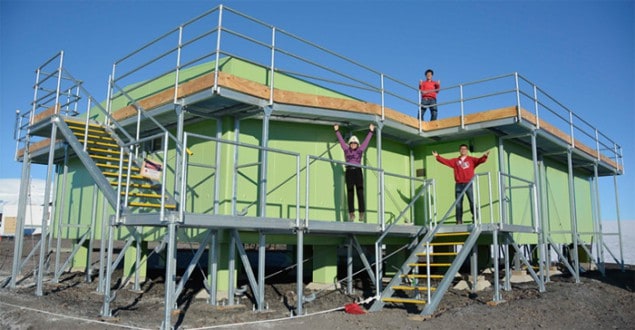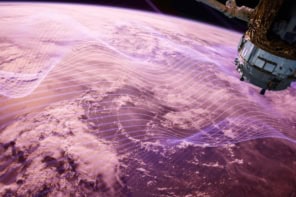
A previously unknown class of wave has been discovered in the Antarctic atmosphere by a team of researchers from the University of Colorado Boulder in the US. These gravity, or buoyancy, waves appear to be a constant presence, being there every time the researchers looked during a five-year study. The team believes that the waves could affect weather and climate patterns, as well as Earth-based communication systems.
The discovery was made using a Fe Boltzmann/Rayleigh temperature LiDAR system at the Arrival Heights Observatory near McMurdo Station, Antarctica. The system uses light pulses to measure atmospheric temperature, and the team’s observations were made after the facility was upgraded in 2010 to make it suitable for year-round measurements of atmospheric temperature, composition and dynamics.
“Although observations in the Antarctic middle and upper atmosphere can be traced back to the 1980s or even earlier, these persistent 3–10 h waves were unknown before the McMurdo LiDAR campaign started providing high-resolution, range-resolved temperature measurements,” explains team-member Cao Chen.
Focus on winter
Chen and his colleagues made observations all year, weather permitting, over a five-year period, from December 2010. But their latest research focuses on data collected every June. Because of the very low solar background radiation, data from the winter months – May to August – provide the highest resolution and largest range of temperature measurements, and the weather is most favourable in June.
“The waves are very easy to see from our raw temperature measurements,” says Chen. The data revealed temperature perturbations that rippled continuously through the mesosphere and lower thermosphere. In the mesopause – a region at an altitude of 80–90 km that separates these two atmospheric layers – the swings in temperature reached around 40 K.
Very different
“Temperature data from the stratosphere to the lower thermosphere (about 30–115 km above the Earth) exhibit persistent, dominant, large-amplitude waves with periods of approximately 3–10 h and vertical wavelengths of approximately 20–30 km,” says Chen. He points out that these waves are very different from waves seen elsewhere on Earth, where waves caused by tidal forces – with 12 h and 24 h oscillation periods – are usually dominant.
The researchers say they are yet to see any days of data without these waves. Indeed, in the middle of the Antarctic winter in 2014, Chen collected data for nearly three days in succession and found that the waves persisted for the entire period. During this 65 h run he recorded five wave events that lasted between 30–60 h, with periods ranging from 3.4–10.6 h.
Endless and uninterrupted
The five years of June data totalled 323 h and included 35 wave events. Waves with periods of 3.5, 5, 6, 6.5 and 7.5 h were found to be the most common, with each occurring at least 25% of the time. In general, the waves have vertical phase velocities of 0.8–2 m/s and they all have long life spans: most lasted at least 10 h and some more than 60 h. According to the researchers, if they are not separated into individual wave events, but regarded as a group of waves, they occur frequently enough to be considered endless and uninterrupted.
These findings are significant, as they provide a rare chance to gain new insight on a poorly observed part of Earth’s atmosphere
Steve Miller, Colorado State University
“These findings are significant, as they provide a rare chance to gain new insight on a poorly observed part of Earth’s atmosphere,” says Steve Miller of Colorado State University, who was not involved in the research. “Waves are the dominant mechanism for energy transport in the middle and upper atmosphere. These waves govern the upper atmospheric circulation, and since the climate system is fully coupled, these high-altitude patterns cascade down to influence the weather patterns of the lower atmosphere and phenomena we experience here at the surface.”
Miller adds that “Confronted with the new observations of this study, numerical models will have an opportunity to improve their representation of important and potentially uncharacterized processes of wave-energy transport. Such improvements are critical to advancing our understanding of climate and our ability to predict climate change.”
The research is described in the Journal of Geophysical Research: Space Physics.



